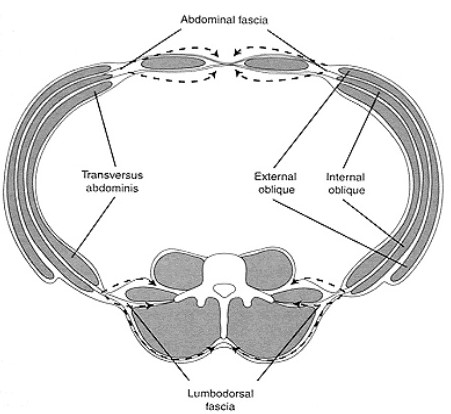(512) 416-7700 | CONTACT US | MAP
Core Strength refers to the proper utilization of smaller stability muscles which function together like pivots, initiating motion smoothly so that power can potentiate along a path. The muscles deep inside the body inform our posture, and the degree of freedom of motion allowed at any particular joint. When our core muscles are strong, engaged, flexible, and working in concert with each other, motion is fluid, powerful and effortless. This ease of motion also markedly reduces our potential for future injury.
Injury happens where the body is restricted in motion, or where it holds tight and does not connect easily to the biomechanical chain above and below. Overwhelming physical forces from sports, accidents, injuries, or even long term postural strains from computer work can compromise the flexible function of these groups of muscles. This is why we make sure forces move smoothly through your weight bearing, and core musculature systems.
 They are the deepest muscles of the body that both initiate and provide stability in global motion. All the abdominal muscles (obliques, transvers, rectus), which communicate through the fascial aponeurosis to the pelvic floor, and through the throacodorsal aponeurosis into the multifidi of the spine (small spinal obliques), and the erector spinae of the back. They form a corset like structure that provides support to the organs, as well as proper coordination of motion throughout the body. Other muscles and deep fascial structures communicate with this bodice to extend coordination into the limbs and the head. Some of these are the glute medius, piriformis, hip rotators, pes ansarine and intermembrane down the legs. These are connected to the shoulder girdle through the psoas and diaphram to the intercostals, serrati, rotator cuff, brachioradials and intermembrane of the forearm. Suboccipitals, sublingual, deep neck flexors, temporalis, frontalis, and pterygoids are extensions of this bodice up into the head. The trick is to get all these muscles engaged before you move, and have them work together.
They are the deepest muscles of the body that both initiate and provide stability in global motion. All the abdominal muscles (obliques, transvers, rectus), which communicate through the fascial aponeurosis to the pelvic floor, and through the throacodorsal aponeurosis into the multifidi of the spine (small spinal obliques), and the erector spinae of the back. They form a corset like structure that provides support to the organs, as well as proper coordination of motion throughout the body. Other muscles and deep fascial structures communicate with this bodice to extend coordination into the limbs and the head. Some of these are the glute medius, piriformis, hip rotators, pes ansarine and intermembrane down the legs. These are connected to the shoulder girdle through the psoas and diaphram to the intercostals, serrati, rotator cuff, brachioradials and intermembrane of the forearm. Suboccipitals, sublingual, deep neck flexors, temporalis, frontalis, and pterygoids are extensions of this bodice up into the head. The trick is to get all these muscles engaged before you move, and have them work together.
They are best exercised together with low weights/force and low reps with higher sets. You can’t do better than planks, push ups, sit ups, leg raises, standing single leg toe touch and extend, and gentle neck/head exercises. Pilates and yoga are also very good for working the core together. Breathing while going through the exercise is important, because these muscles are connected to breath. In fact if you make the “shhhhhh” sound you will feel most of these muscles coming on. Try to make the “shhhhh” sound while doing your core exercise and notice if it makes the exercise easier. These are small muscles, so keeping a good form is necessary to actually engage the muscles you are trying to work. Though these exercise can be hard, and can produce a sweat with just small motions, they should not cause pain. If an exercise causes you pain, stop. Do the ones that feel good. Give your core some love and it will pay you back exponentially throughout your life.
When you lose the most basic functions of core strength, you have a hard time getting up off the floor, and your potential for instability and falls increase greatly. It is never too late to work your core. Chiropractic, pilates, water aerobics, and even chair core exercises can get you moving in the right direction again and restore your core strength.
We make sure you are moving forces normally through your weight bearing structures, along all motion planes and while walking, to make it easier to connect with your core strength again. We also collaborate with trainers, PTs and biomechanical therapists in the area to recondition your movement patterns after the muscles are able to engage properly.